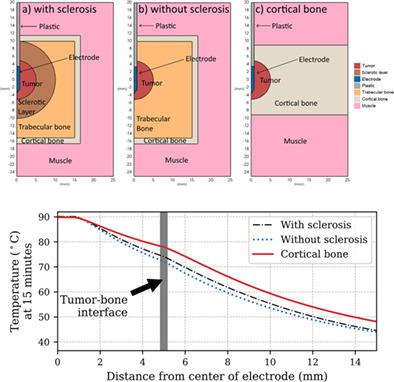当前位置:
X-MOL 学术
›
Int. J. Numer. Method. Biomed. Eng.
›
论文详情
Our official English website, www.x-mol.net, welcomes your
feedback! (Note: you will need to create a separate account there.)
Effects of control temperature, ablation time, and background tissue in radiofrequency ablation of osteoid osteoma: A computer modeling study
International Journal for Numerical Methods in Biomedical Engineering ( IF 2.2 ) Pub Date : 2021-07-27 , DOI: 10.1002/cnm.3512 Ricardo Rivas 1 , Rudy B Hijlkema 2 , Ludo J Cornelissen 1 , Thomas C Kwee 3 , Paul C Jutte 4 , Peter M A van Ooijen 1
International Journal for Numerical Methods in Biomedical Engineering ( IF 2.2 ) Pub Date : 2021-07-27 , DOI: 10.1002/cnm.3512 Ricardo Rivas 1 , Rudy B Hijlkema 2 , Ludo J Cornelissen 1 , Thomas C Kwee 3 , Paul C Jutte 4 , Peter M A van Ooijen 1
Affiliation

|
To study the effects of the control temperature, ablation time, and the background tissue surrounding the tumor on the size of the ablation zone on radiofrequency ablation (RFA) of osteoid osteoma (OO). Finite element models of non-cooled temperature-controlled RFA of typical OOs were developed to determine the resulting ablation radius at control temperatures of 70, 80, and 90°C. Three different geometries were used, mimicking common cases of OO. The ablation radius was obtained by using the Arrhenius equation to determine cell viability. Ablation radii were larger for higher temperatures and also increased with time. All geometries and control temperatures tested had ablation radii larger than the tumor. The ablation radius developed rapidly in the first few minutes for all geometries and control temperatures tested, developing slowly towards the end of the ablation. Resistive heating and the temperature distribution showed differences depending on background tissue properties, resulting in differences in the ablation radius on each geometry. The ablation radius has a clear dependency not only on the properties of the tumor but also on the background tissue. Lower background tissue's electrical conductivity and blood perfusion rates seem to result in larger ablation zones. The differences observed between the different geometries suggest the need for patient-specific planning, as the anatomical variations could cause significantly different outcomes where models like the one here presented could help to guarantee safe and successful tumor ablations.
中文翻译:

控制温度、消融时间和背景组织在骨样骨瘤射频消融中的影响:计算机建模研究
研究控制温度、消融时间和肿瘤周围背景组织对骨样骨瘤(OO)射频消融(RFA)消融区大小的影响。开发了典型 OO 的非冷却温控 RFA 的有限元模型,以确定在 70、80 和 90°C 的控制温度下产生的烧蚀半径。使用了三种不同的几何形状,模仿了 OO 的常见情况。消融半径通过使用 Arrhenius 方程确定细胞活力来获得。温度越高,烧蚀半径越大,而且随着时间的推移而增加。测试的所有几何形状和控制温度的消融半径都大于肿瘤。对于所有测试的几何形状和控制温度,烧蚀半径在最初几分钟内迅速发展,在消融结束时缓慢发展。电阻加热和温度分布因背景组织特性而异,导致每个几何形状的消融半径存在差异。消融半径不仅与肿瘤的特性有关,而且与背景组织有关。较低的背景组织的电导率和血液灌注率似乎会导致较大的消融区。不同几何形状之间观察到的差异表明需要针对患者进行规划,因为解剖变化可能会导致显着不同的结果,而此处介绍的模型可能有助于确保安全和成功的肿瘤消融。电阻加热和温度分布因背景组织特性而异,导致每个几何形状的消融半径存在差异。消融半径不仅与肿瘤的特性有关,而且与背景组织有关。较低的背景组织的电导率和血液灌注率似乎会导致较大的消融区。不同几何形状之间观察到的差异表明需要针对患者进行规划,因为解剖变化可能会导致显着不同的结果,而此处介绍的模型可能有助于确保安全和成功的肿瘤消融。电阻加热和温度分布因背景组织特性而异,导致每个几何形状的消融半径存在差异。消融半径不仅与肿瘤的特性有关,而且与背景组织有关。较低的背景组织的电导率和血液灌注率似乎会导致较大的消融区。不同几何形状之间观察到的差异表明需要针对患者进行规划,因为解剖变化可能会导致显着不同的结果,而此处介绍的模型可能有助于确保安全和成功的肿瘤消融。消融半径不仅与肿瘤的特性有关,而且与背景组织有关。较低的背景组织的电导率和血液灌注率似乎会导致较大的消融区。不同几何形状之间观察到的差异表明需要针对患者进行规划,因为解剖变化可能会导致显着不同的结果,而此处介绍的模型可能有助于确保安全和成功的肿瘤消融。消融半径不仅与肿瘤的特性有关,而且与背景组织有关。较低的背景组织的电导率和血液灌注率似乎会导致较大的消融区。不同几何形状之间观察到的差异表明需要针对患者进行规划,因为解剖变化可能会导致显着不同的结果,而此处介绍的模型可能有助于确保安全和成功的肿瘤消融。
更新日期:2021-09-14
中文翻译:

控制温度、消融时间和背景组织在骨样骨瘤射频消融中的影响:计算机建模研究
研究控制温度、消融时间和肿瘤周围背景组织对骨样骨瘤(OO)射频消融(RFA)消融区大小的影响。开发了典型 OO 的非冷却温控 RFA 的有限元模型,以确定在 70、80 和 90°C 的控制温度下产生的烧蚀半径。使用了三种不同的几何形状,模仿了 OO 的常见情况。消融半径通过使用 Arrhenius 方程确定细胞活力来获得。温度越高,烧蚀半径越大,而且随着时间的推移而增加。测试的所有几何形状和控制温度的消融半径都大于肿瘤。对于所有测试的几何形状和控制温度,烧蚀半径在最初几分钟内迅速发展,在消融结束时缓慢发展。电阻加热和温度分布因背景组织特性而异,导致每个几何形状的消融半径存在差异。消融半径不仅与肿瘤的特性有关,而且与背景组织有关。较低的背景组织的电导率和血液灌注率似乎会导致较大的消融区。不同几何形状之间观察到的差异表明需要针对患者进行规划,因为解剖变化可能会导致显着不同的结果,而此处介绍的模型可能有助于确保安全和成功的肿瘤消融。电阻加热和温度分布因背景组织特性而异,导致每个几何形状的消融半径存在差异。消融半径不仅与肿瘤的特性有关,而且与背景组织有关。较低的背景组织的电导率和血液灌注率似乎会导致较大的消融区。不同几何形状之间观察到的差异表明需要针对患者进行规划,因为解剖变化可能会导致显着不同的结果,而此处介绍的模型可能有助于确保安全和成功的肿瘤消融。电阻加热和温度分布因背景组织特性而异,导致每个几何形状的消融半径存在差异。消融半径不仅与肿瘤的特性有关,而且与背景组织有关。较低的背景组织的电导率和血液灌注率似乎会导致较大的消融区。不同几何形状之间观察到的差异表明需要针对患者进行规划,因为解剖变化可能会导致显着不同的结果,而此处介绍的模型可能有助于确保安全和成功的肿瘤消融。消融半径不仅与肿瘤的特性有关,而且与背景组织有关。较低的背景组织的电导率和血液灌注率似乎会导致较大的消融区。不同几何形状之间观察到的差异表明需要针对患者进行规划,因为解剖变化可能会导致显着不同的结果,而此处介绍的模型可能有助于确保安全和成功的肿瘤消融。消融半径不仅与肿瘤的特性有关,而且与背景组织有关。较低的背景组织的电导率和血液灌注率似乎会导致较大的消融区。不同几何形状之间观察到的差异表明需要针对患者进行规划,因为解剖变化可能会导致显着不同的结果,而此处介绍的模型可能有助于确保安全和成功的肿瘤消融。











































 京公网安备 11010802027423号
京公网安备 11010802027423号